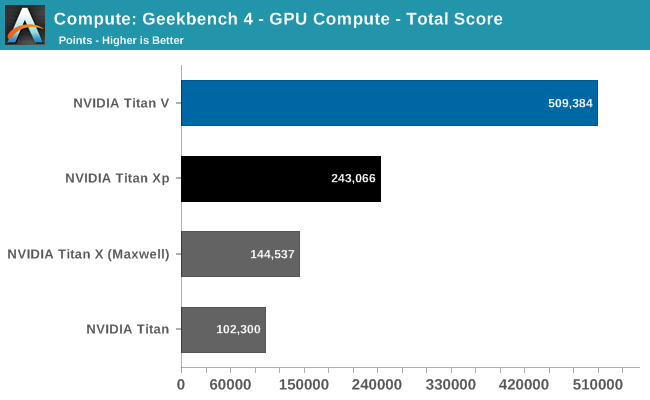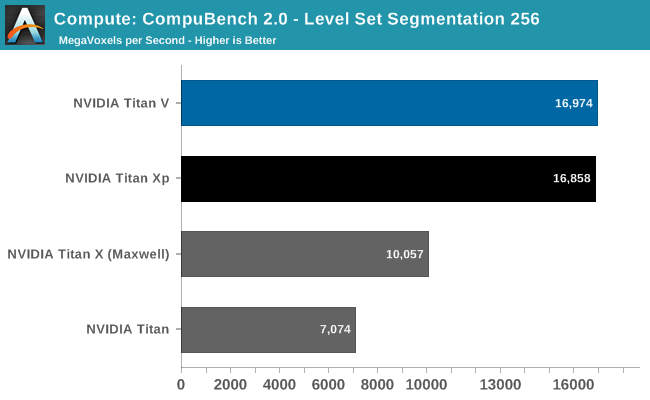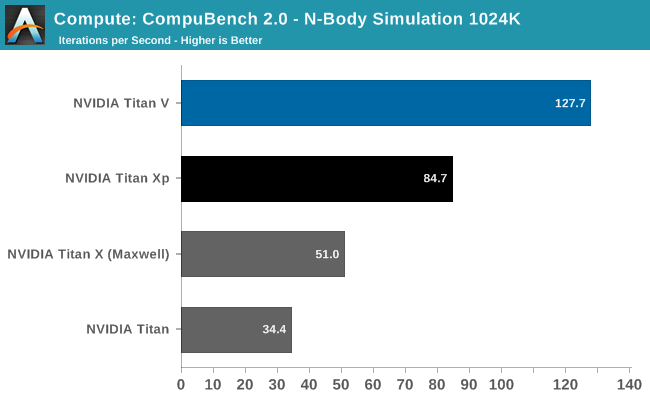The NVIDIA Titan V Preview - Titanomachy: War of the Titans
by Ryan Smith & Nate Oh on December 20, 2017 11:30 AM ESTCompute Performance: Geekbench 4
In the most recent version of its cross-platform Geekbench benchmark suite, Primate Labs added CUDA and OpenCL GPU benchmarks. This isn’t normally a test we turn to for GPUs, but for the Titan V launch it offers us another perspective on performance.

The results here are interesting. We’re not the only site to run Geekbench 4, and I’ve seen other sites with much different scores. But as we haven’t used this benchmark in great depth before, I’m hesitant to read too much into it. What it does show us, at any rate, is that the Titan V is well ahead of the Titan Xp here, more than doubling the latter’s score.
| NVIDIA Titan Cards GeekBench 4 Subscores | ||||||
| Titan V | Titan Xp | GTX Titan X | GTX Titan | |||
| Sobel (GigaPixels per second) |
35.1 | 24.9 | 16.5 | 9.4 | ||
| Histogram Equalization (GigaPixels per second) |
21.2 | 9.43 | 5.58 | 4.27 | ||
| SFFT (GFLOPS) |
180 | 136.5 | 83 | 60.3 | ||
| Gaussian Blur (GigaPixels per second) |
23.9 | 2.67 | 1.57 | 1.45 | ||
| Face Detection (Msubwindows per second) |
21.7 | 12.4 | 8.66 | 4.92 | ||
| RAW (GigaPixels per second) |
18.2 | 10.8 | 5.63 | 4.12 | ||
| Depth of Field (GigaPixels per second) |
3.31 | 2.74 | 1.35 | 0.72 | ||
| Particle Physics (FPS) |
83885 | 30344 | 18725 | 18178 | ||
Looking at the subscores, the Titan V handily outperforms the Titan Xp on all of the subtests. However it’s one test in particular that stands out here, and is likely responsible for the huge jump in the overall score, and that’s the Gaussian Blur, where the Titan V is 9x (!) faster than the Titan Xp. I am honestly not convinced that this isn’t a driver or benchmark bug of some sort, but it may very well be that Primate Labs has hit on a specific workload or scenario that sees some rather extreme benefits from the Volta architecture.
Folding @ Home
Up next we have the official Folding @ Home benchmark. Folding @ Home is the popular Stanford-backed research and distributed computing initiative that has work distributed to millions of volunteer computers over the internet, each of which is responsible for a tiny slice of a protein folding simulation. FAHBench can test both single precision and double precision floating point performance, giving us a good opportunity to let Titan V flex its FP64 muscles.

A CUDA-backed benchmark, this is the first sign that Titan V’s performance lead over the Titan Xp won’t be consistent. And more specifically that existing software and possibly even NVIDIA’s drivers aren’t well-tuned to take advantage of the Volta architecture just yet.
In this case the Titan V actually loses to the Titan Xp ever so slightly. The scores are close enough that this is within the usual 3% margin of error, which is to say that it’s a wash overall. But it goes to show that Titan V isn’t going to be an immediate win everywhere for existing software.
CompuBench
Our final set of compute benchmarks is another member of our standard compute benchmark suite: CompuBench 2.0, the latest iteration of Kishonti's GPU compute benchmark suite. CompuBench offers a wide array of different practical compute workloads, and we’ve decided to focus on level set segmentation, optical flow modeling, and N-Body physics simulations.



It’s interesting how the results here are all over the place. The Titan V shows a massive performance improvement in both N-Body simulations and Optical Flow, once again leading to the Titan V punching well above its weight. But then the Level Set Segmentation benchmark is practically tied with the Titan Xp. Suffice it to say that this puts the Titan V in a great light, and conversely makes one wonder how the Titan Xp was (apparently) so inefficient. The flip side is that it’s going to be a while until we fully understand why certain workloads seem to benefit more from Volta than other workloads.










111 Comments
View All Comments
WB312 - Friday, December 22, 2017 - link
I am from the future, we still can't run Crysis.mode_13h - Wednesday, December 27, 2017 - link
HDMI 2.1 already supports 10k @ 120 Hz, so the bar moves ever higher.Yojimbo - Wednesday, December 20, 2017 - link
Small error: "Rather both Tesla P100 and Titan V ship with 80 SMs enabled, making for a total of 5120 FP32 CUDA cores and 672 tensor cores."80 x 8 = 640. The P100 and Titan V each have 640 tensor cores. 672 is what a full GV100 has.
jabbadap - Wednesday, December 20, 2017 - link
Yeah and that would be Tesla V100, P100 is pascal.Yojimbo - Wednesday, December 20, 2017 - link
Yeah true. I didn't notice that.rocky12345 - Wednesday, December 20, 2017 - link
Great preview of the new Titan V card thank you. I really got a kick out of the "But Can It Run Crysis?" part and you actually gave numbers to back up that question which of coarse it can pretty well.007ELmO - Wednesday, December 20, 2017 - link
of course...it's only a $3000 carddjayjp - Wednesday, December 20, 2017 - link
Crysis at 8K equivalent! 4k = 8 million pixels x 4 super sampled becomes 32 MP. Tho that means there'd be no AA if run on an 8k monitor..and what about 99th percentile? ;)nedjinski - Wednesday, December 20, 2017 - link
what will nvidia do about that nagging crypto mining problem?lazarpandar - Wednesday, December 20, 2017 - link
Make it cost 3kMachine learning is more valuable than crypto